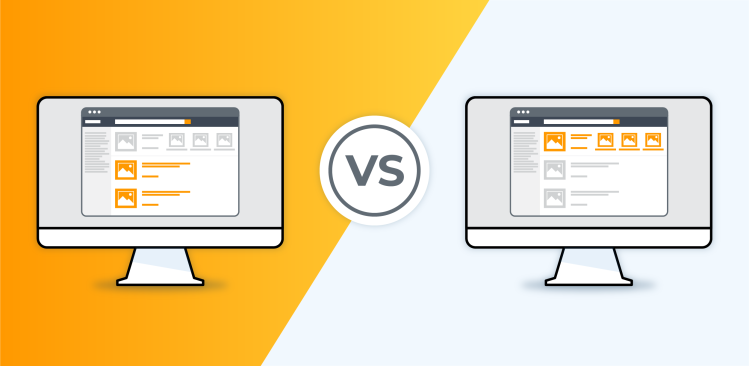
Sponsored Products vs Sponsored Brands: Why You Need Both
Zoë MacDonald, November 5, 2020
If you’re selling on Amazon - you’re buying ad space on Amazon. A quick look at the ad real estate on the search results page clarifies why: Nine times out of ten, there are little (or no) organic listings above the fold.
That means even if - or maybe especially if - your product is ranking and selling well on Amazon, it remains essential to invest in ads. And, why wouldn’t you? With ad revenue higher than ever since the global increase in demand for eCommerce, it’s a no-brainer.
With the right strategy, increasing your revenue through ads is easy. Better yet, it’s worth it.
Amazon offers sellers and vendors plenty of opportunities to put their product in front of the right audience, in the form of Sponsored Products, Sponsored Brands, and (new) Sponsored Display Ads.
But are all ad formats created equally? Not according to most sellers and vendors on the platform.
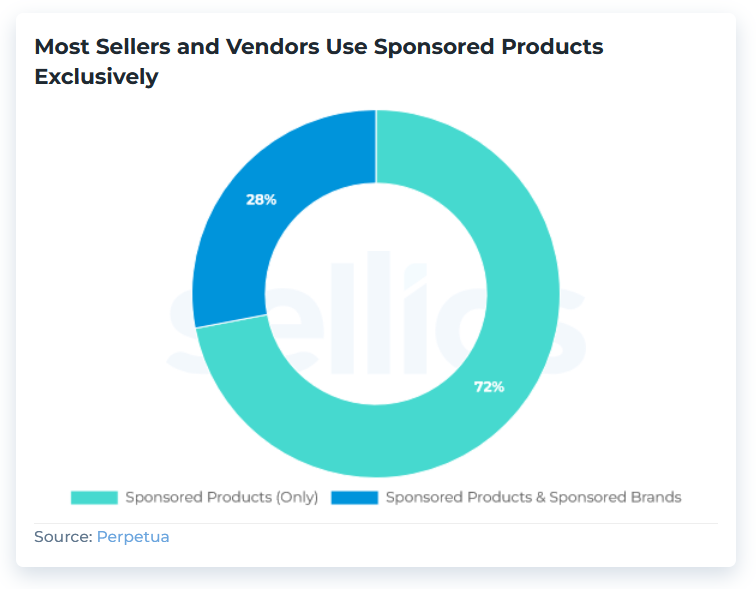
Out of all of the vendors and sellers who use Sponsored Products, less than a third are also using Sponsored Brands.
And, those who are using Sponsored Brands only derive 11% of their ad revenue from this format.
So are Sponsored Brands simply an inferior format?
We’re not convinced.
Sponsored Brands occupy the very top spot on the search results page. They offer greater creative control, more brand exposure, and the opportunity to send shoppers directly to your custom build brand store.
With so much potential, why does this format continue to be under-utilized?
To get some answers, let’s dive a little deeper into the data.
But first - about the data:
Sponsored Brands ads consist of three formats: Product Collection, Store Spotlight, and Video. For this analysis, so that we're comparing apples to apples, we’re excluding Sponsored Brands Video.
Our analysis is based on anonymized Sponsored Products & Sponsored Brands performance data from close to 1,000 US advertiser profiles managed with Sellics. The trends and figures included do not represent an official performance statement of Amazon Advertising.
Looking for more Amazon PPC background, data, and insights?
Whether you’re interested in a high-level analysis of Amazon Advertising, a detailed look at recent marketplace trends, or a deep dive into the nuances of specific product categories, our 2022 Amazon Advertising Benchmark Report can help you gain insight into the Amazon PPC landscape.
The report is based on a comprehensive analysis of over 2 million Sponsored Products campaigns and you can download it for free today.
Sponsored Products vs. Sponsored Brands: Performance Metrics
Sponsored Brands vs Sponsored Products: Click-Through-Rate

The median click-through-rate for Sponsored Products is 0.42%, and Sponsored Brands 0.38% - meaning that when looking at average-performing ads from a click-through-rate perspective, Sponsored Brands perform worse - with an 11% lower click-through-rate.
This gap is exaggerated among the worst performers. The worst performing Sponsored Brands ads have a click-through-rate which is 33% lower than Sponsored Products.
However, the best performers perform better! Looking at the top 20% performers, the click-through-rate is 11% higher in favor of Sponsored Brands.
In other words, the margin for error is greater with Sponsored Brands - as far as click-through-rates go.
Are you looking for the average click-through-rate?
We’re using median numbers by percentile groups for this piece and not averages. With performance varying so much, averages are unreliable as they risk being swayed by outliers. As a result, the “average” might have little to do with most users’ experiences.
Think of percentiles as clusters of different scores within a range, divided into sections with the percentile score representing the highest score in that group.
For example, the worst-performing 20% of Sponsored Brands ads have a click-through-rate of 0.21% or lower.
This could be explained by the fact that most shoppers generally don’t like to click on “ads”. And, Sponsored Brands are less covert than Sponsored Products. They look much more like traditional ads - if only because of their familiar banner shape.
To earn the click, brands have to make an especially compelling offer. The good news is the format provides the resources to do so. Like showcasing a captivating brand store with a Store Spotlight Ad, or showing off a related best-selling product in a Product Collection ad.
This explains why, when done right, Sponsored Brands have the potential to outperform Sponsored Products clicks-wise.
Is your click-through-rate for Sponsored Products and Sponsored Brands better or worse than your direct competitor's?
Get early access to the Benchmarker to find out.
Sponsored Brands vs Sponsored Products: Conversion Rate

No surprise here - the median conversion rate for Sponsored Products is 13% higher than Sponsored Brands’. This gap is relatively consistent across different performance levels, except at the bottom.
You might have guessed: The worst converting Sponsored Brands ads have a conversion rate 23% lower than Sponsored Products. So, much worse.
But conversion rate might not be the best metric for measuring Sponsored Brands’ performance. Sponsored Brands ads are much more likely to have upper-funnel goals, such as creating brand awareness.
With a brand awareness campaign, impressions are more likely to be a KPI - while the impact on sales and conversions is less immediate. You can imagine, for example, recalling a brand that you have seen on Amazon and searching for their products at a later date - past the 7-day attribution window even.
In fact, research by Amazon suggests that using Sponsored Products and Sponsored Brands together increases overall conversion rate by 50% and ROAS by 24%.
So a lower conversion rate doesn’t necessarily mean the ad’s not “working”.
Speaking of the marketing funnel, you should consider the possible difference in buyers’ intent. If a shopper clicks on a Sponsored Product Ad, it may be more likely that they know what they want and are ready to buy - while clicking on a store or a banner-shaped ad could be an indication that the shopper is browsing or at an earlier stage in the purchasing journey.
Is your conversion rate for Sponsored Products and Sponsored Brands better or worse than other advertisers’ in your category and marketplace?
To find out, get early access to the (new, free) Benchmarker.
Sponsored Brands vs Sponsored Products: CPC

The median cost-per-click is the same for both ad types at $0.64. The more significant variance, of course, will be by product category - which we’ll dive into a little later.
It’s also worth noting that for most other performance levels, including the top and bottom 20%, CPC is a bit lower for Sponsored Brands - between four and eight percent lower.
This discrepancy is likely due to reduced competition. A lower adoption rate of the format means less bidders, less bids, and ultimately a lower price at auction.
As always, a lower CPC spells huge potential.
Are you paying too much per click?
Find out how your CPC compares to others' in your same marketplace and category with the Benchmarker.
Sponsored Brands vs Sponsored Products: ACoS
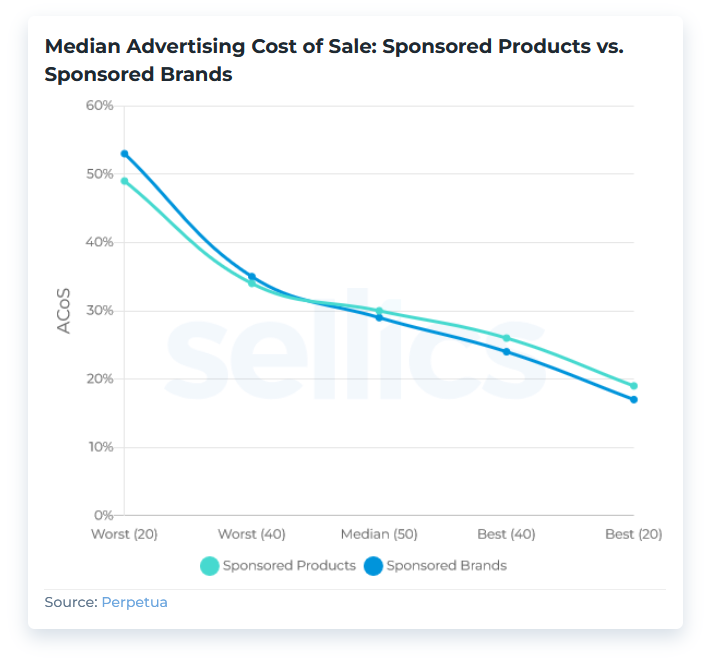
Final sales considered, Sponsored Brands cost a little less per sale. But both figures are comparable and fall within the range of a ‘good’ or acceptable ACoS.
Comparing ACoS from best-performers to worst-performers, results are mixed. This is because ACoS depends on a range of different KPIs – mainly Cost Per Click (CPC), conversion rate, and Average Selling Price (ASP).
While conversion rates tend to be lower for Sponsored Brands, they also tend to have a lower CPC. The unique mix of these KPIs in a certain segment determines the ACoS. E.g. for the best-performers, Sponsored Brands have a 12% lower ACoS.
Is your ACoS “good”?
Find out - for free - by benchmarking your performance with others in your same category and marketplace, with the Benchmarker.
Key Takeaways: Sponsored Products vs Sponsored Brands
At first glance, some key metrics (click-through-rate and conversion rate) suggest that Sponsored Brands are worse performers. But, In fact, for some product categories, Sponsored Brands perform even better than Sponsored Products. More on that in a bit.
First, let’s recap what we’ve learned so far.
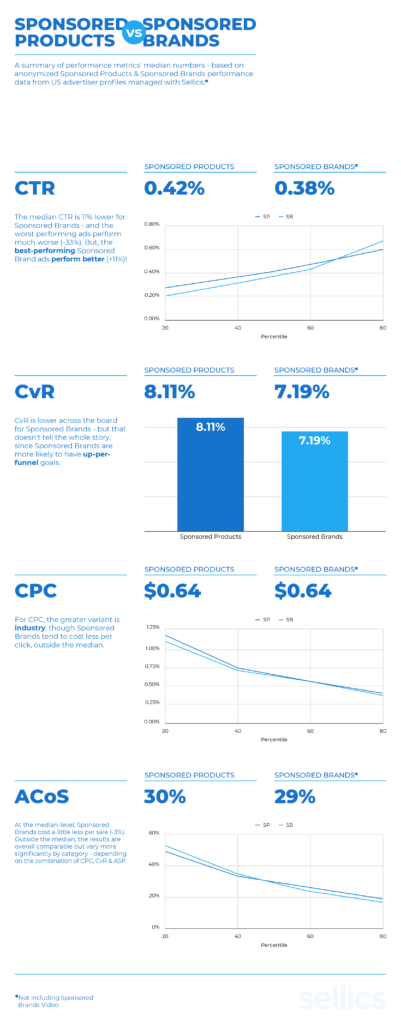
Are Sponsored Brands Worth It for Your Brand? The Top Five Categories for Sponsored Brands
Earlier we mentioned that in some cases, Sponsored Brands ads perform better than Sponsored Products. Here are the top-five categories where median-performing Sponsored Brands ads have a lower ACoS than Sponsored Products.
Top 5 Categories Where Sponsored Brands Have a Lower ACoS
For these five categories, ACoS is lower for Sponsored Brands than Sponsored Products, by the percentage above. And yet, the adoption rates are not much - if at all - higher than average.
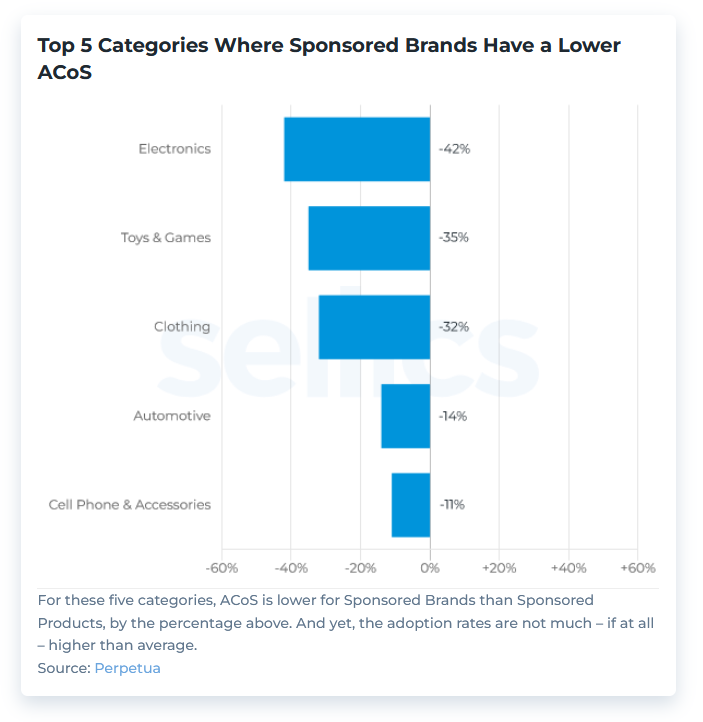
Despite this, the adoption figures for the above categories aren’t much higher than average, if at all: They hover between 24 and 33%.
And, of those who’ve adopted the format, they derive only between 6 and 20% of their total ad revenue from Sponsored Brands - despite getting a better return.
This gap suggests that there’s still a lot of untapped potential here.
Let’s have a closer look at our top five categories for which the median performing Sponsored Brands Ads perform better than Sponsored Products.
1. Electronics
Sponsored Brands Performance: Electronics
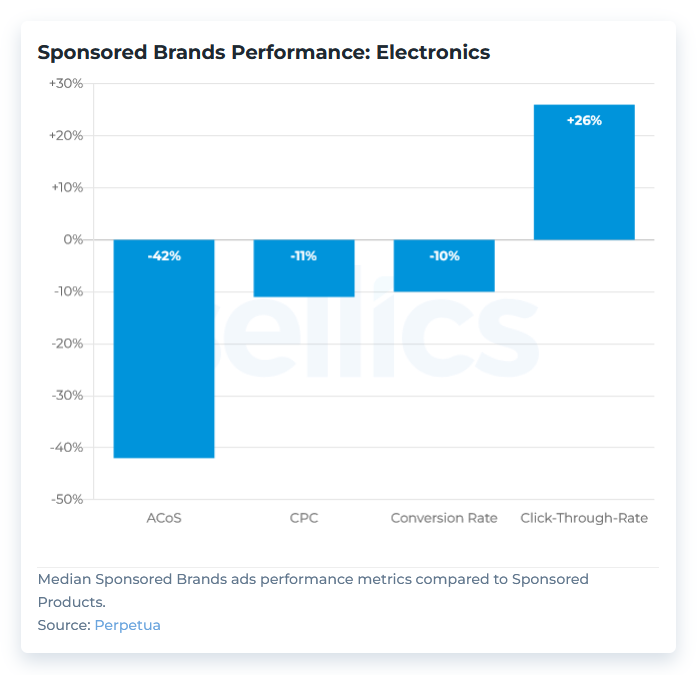
Most of the top-performing categories, including Electronics, have a lower CPC, and, likely, a higher ASP, to thank for a lower ACoS.
In Electronics Sponsored Brands Ads also tend to have a higher click-through-rate. Why?
It might be a combination of customers:
Putting more value on brands for ‘lifestyle products’ such as home audio products, eReaders, headphones, and so on. And,
Performing more comprehensive product research.
Anyone who’s ever ordered a comically small version of the item they were looking for has realized that one doesn’t always read the description carefully when placing an order online.
But, this is much less likely to happen when purchasing electronics: We care about the features and quality of electronic devices. We may need to know specific details about use and compatibility to adequately address our needs.
Here, the challenge is getting shoppers to take the plunge and commit to convert.
2. Toys & Games
Sponsored Brands Performance: Toys & Games
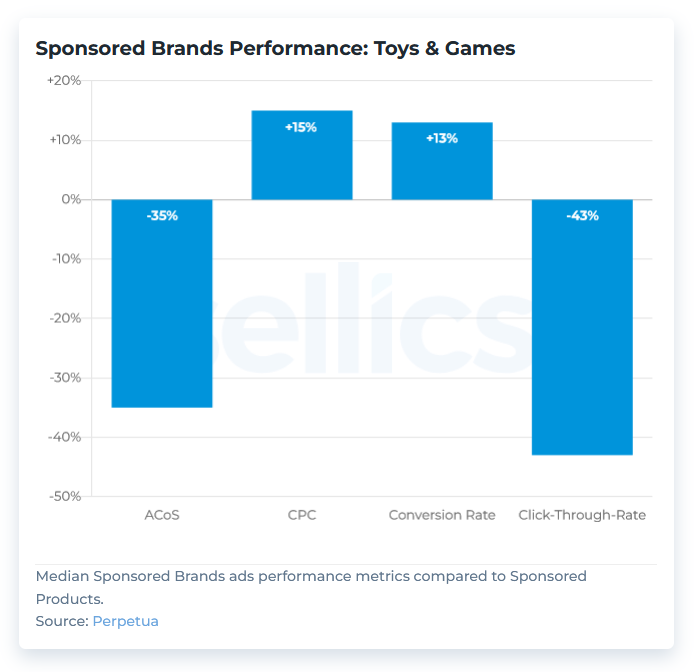
Toys & Games is the only category on this list for which the CPC is higher for Sponsored Brands. Toys & Games is a highly competitive category for which brand is expected to play an important role.
A high CPC is likely to be the sign of a good defensive strategy by larger brands like Barbie and Disney. When searching for these brands or related product keywords, they have a vested interest in being found before competitors.
Still, the ads yield a lower ACoS than their Sponsored Products counterparts thanks to a high conversion rate - suggesting that those who do click are even more likely to buy: Shoppers who are open to browsing Toys & Games tend to find what they’re looking for after clicking on a Sponsored Brands ad.
3. Clothing
Sponsored Brands Performance: Clothing
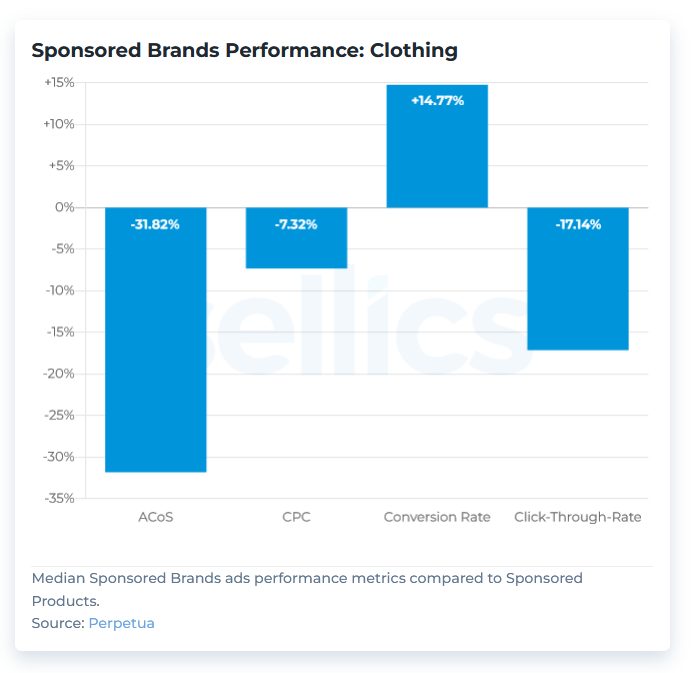
In Clothing, lower CPCs and higher conversion rates lead to a better ACoS.
Why might clothing have a higher conversion rate?
One possible explanation: browsing. Is there any product range more conventionally browsable than clothing? Brand stores - which are usually accessed exclusively through Sponsored Brands ads - are likely to offer a much better shopping experience for browsing: One that more closely resembles that of a bricks and mortar store.
A better experience increases the likelihood of making a purchase. Finally, shoppers might discover products they ultimately buy that they wouldn’t otherwise have searched for directly.
Intuitively, it makes sense for shoppers to enter a store with one item in mind and end up buying something else that catches their eye when shopping for clothing.
In this case, the challenge is getting shoppers “in the door” in the first place.
4. Automotive
Sponsored Brands Performance: Automotive
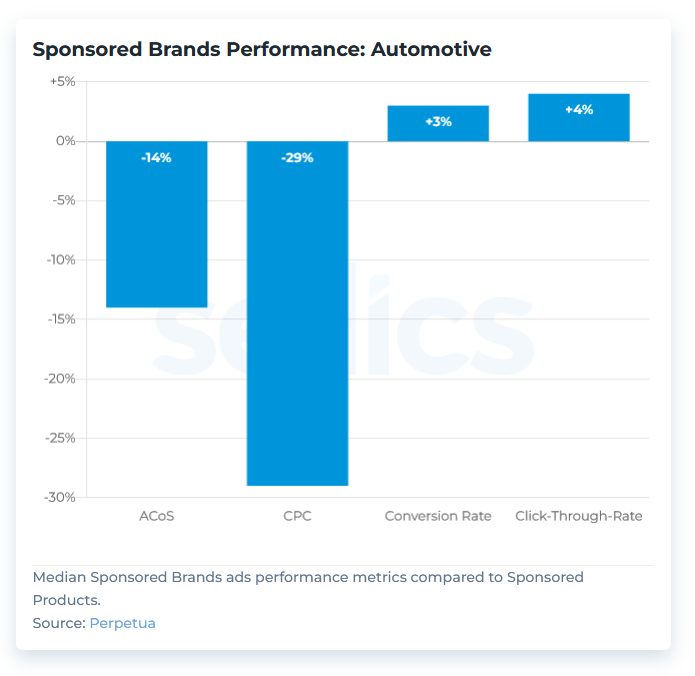
Sponsored Brands in the automotive category have everything going for them. Compared to Sponsored Products, all of the performance metrics are ‘better’: a much lower CPC, higher conversion rate and click-through-rate and - of course - a lower ACoS.
Automotive is a category where brand matters, and trust is very important which, again, places emphasis on brand. For automotive products, there may also be a question of compatibility - similar to Electronics.
Given that, it’s no surprise that shoppers might be more likely to click on a brand logo or branded store in this context.
5. Cell Phone & Accessories
Sponsored Brands Performance: Cell Phone & Accessories
Sponsored Brands Performance: Cell Phone & Accessories
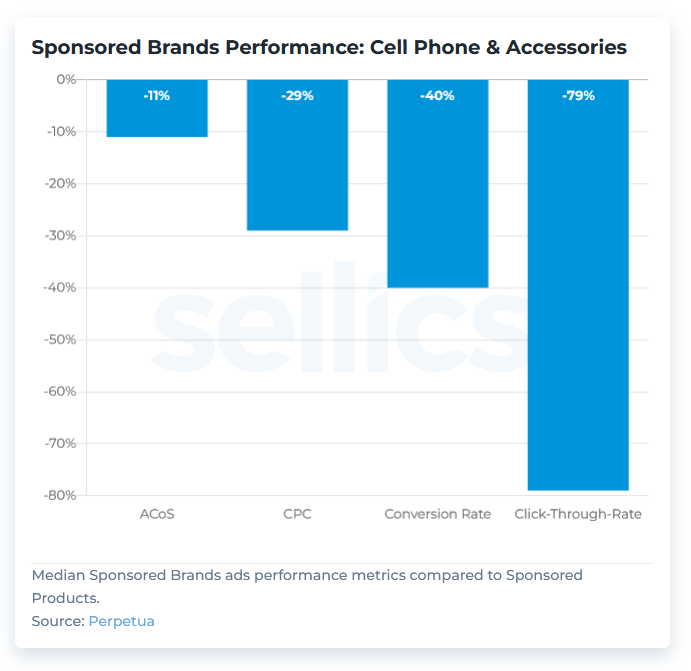
Despite a much much lower conversion rate, because of the low CPC, ACoS is still lower than that of Sponsored Products - even though clicks and purchases are fewer.
I’ll admit, this category is a bit of a wildcard - but that highlights the importance of testing formats and not relying on intuition around brand relevance in your category.
At first glance, the metrics look poor - but at the end of the day it’s RoAS and not engagement that matters. Sponsored Brands are bringing in more revenue for ad spend.
Conclusion: How To Use Sponsored Brands Ads (in Addition to Sponsored Products)
Sponsored Brands tend to perform better than Sponsored Products in terms of ACoS in categories where CPCs are lower and conversion rates are higher for Sponsored Brands.
Electronics (-42% ACoS)
Toys & Games (-35% ACoS)
Clothing (-32% ACoS)
Automotive (-14% ACoS)
Cell Phones & Accessories (-11% ACoS)
Looking at the top categories most of them (4 of 5) have lower CPCs in Sponsored Brands than in Sponsored Products: There is a window of opportunity here. Advertisers can benefit from less competition.
There is also a higher conversion rate for Sponsored Brands in 3 of the 5 best performers. This is most likely because shoppers are more focused on brands in these categories and therefore value or respond positively to a branded shopping experience provided by Sponsored Brands Ads and brand stores.
However, running successful Sponsored Brands campaigns is certainly not limited to the categories identified above.
We suggest that you:
Implement Sponsored Brands ads now.For now, CPCs are lower for Sponsored Brands, while the format is underrated and underutilized. This won’t last forever. Implement Sponsored Brands if you haven’t already and follow best practices guidelines for optimal results.
Optimize your ads.Work on optimizing underperforming metrics by employing A/B testing to see what works best for your marketplace and category.
Benchmark your performance to find potential areas of improvement.Use the Benchmarker to compare your KPIs (click-through-rate, conversion rate, CPC, ACoS, ROAS) against the benchmarks in your peer group by category and marketplace to get an understanding of the conditions for Sponsored Products and Sponsored Brands in your segment. Use these insights to identify optimization potential and windows of opportunity.
Finally, remember that in addition to the bare metrics and ad profit, Sponsored Brands ads have the potential to serve upper funnel goals and that moving your ad strategy gradually up the funnel is one sure way to secure long term success on Amazon.
Ultimately, believing that Sponsored Brands plays second fiddle to Sponsored Products means a missed opportunity. Understanding their potential, it’s more useful to think of both formats as partners.
Sponsored Brands ads generally have the goal of generating brand awareness and consideration (high and mid funnel) versus direct purchases (low funnel). That means they are designed to prepare purchases that happen at a later stage - despite those conversions not being attributed directly to the Sponsored Brands ad.
As mentioned, research by Amazon suggests that using Sponsored Products and Sponsored Brands together increases overall conversion rate by 50% and ROAS by 24%.
It’s only a matter of time before more sellers and vendors catch on. Now’s your chance to hit the ground running.
To get started or learn more about how Perpetua can help you scale your Amazon Advertising business, contact us at hello@perpetua.io